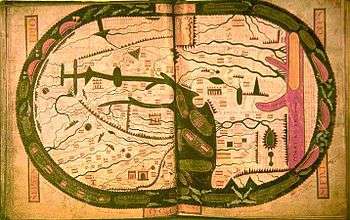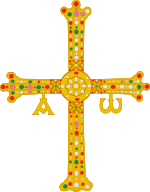Beatus of Liébana
| Saint Beatus | |
|---|---|
|
The world map from the Saint-Sever Beatus measuring 37 X 57 cm. This was painted c. 1050 as an illustration to Beatus's work at the Abbey of Saint-Sever in Aquitaine, on the order of Gregori de Montaner, Abbot from 1028 to 1072. | |
| Born |
c. 730 Duchy of Cantabria, Kingdom of Asturias |
| Died |
c. 800 Liébana, Cantabria, Kingdom of Asturias |
| Venerated in |
Roman Catholic Church Orthodox Catholic Church |
| Feast | February 19 |

Saint Beatus of Liébana (c. 730 – c. 800) was a monk, theologian and geographer from the former Duchy of Cantabria and Kingdom of Asturias, in modern Cantabria, northern Spain, who worked and lived in the Picos de Europa mountains of the region of Liébana. He is best remembered today as the author of the Commentary on the Apocalypse.
Biography
Beatus was likely born and raised in Liébana, possibly from a poor family. As confessor to Adosinda, wife of Silo of Asturias, and as the master of Alcuin and Etherius of Osma, Beatus exercised wide influence.[2]
He is best remembered today as the author of the Commentary on the Apocalypse, written in 776, then revised in 784 and again in 786. He corresponded with Alcuin, and took part in the Adoptionist controversy, criticizing the views of Felix of Urgel and Elipandus of Toledo. Archbishop Elipandus claimed that in respect to his human nature – Christ was the "adoptive" Son of God.[2]
Beatus and Etherius, later bishop of Osma, wrote refuting this heresy. Elipandus complained to Abbot Fidelis in a scathing letter attacking Beatus as an impudent, interfering, vagrant mountaineer and insisted that Beatus amend his ways or be delivered to the archbishop for correction. Beatus responded with a book on the orthodox teachings of the Church. Alcuin praised Beatus for his writings and described him as a learned and holy man.[2]
The Commentary was popular during the Middle Ages and survives in at least 34 manuscripts (usually called a beatus) from the 10th through the 16th centuries. At least 26 of those manuscripts contain illuminations. Though Beatus may have written his commentaries as a response to Adoptionism in Hispania of the late 8th century, many believe that the book's popularity in monasteries stemmed from the presence in Iberia of Islam. Not all of the manuscripts are complete, and some exist only in fragmentary form. Twenty-six of these manuscripts are lavishly decorated in the Mozarabic, Romanesque, or Gothic style of illumination.
Author and theologian
It is a work of erudition but without great originality, made up principally of compilations. Beatus includes long extracts from the texts of the Fathers of the Church and Doctors of the Church, especially Augustine of Hippo (Saint Augustine), Ambrose of Milan (Saint Ambrose), Tyconius, Irenaeus of Lyon (Saint Irenaeus), and Isidore of Seville (Saint Isidore). He adds to this the commentary on the Book of Daniel by Jerome of Stridon (Saint Jerome).
The Beatus text was regarded as a symbol of Christian resistance to the Muslim Arabs who dominated much of the Iberian Peninsula in the early Middle Ages.
Further reading
| Wikimedia Commons has media related to Illustrated Beatus manuscripts. |
For more information on Beatus of Liébana or on the Beatus Apocalypse manuscripts, see the studies carried out by John Williams, Mireille Mentre, José Camón Aznar, Wilhelm Neuss and Joaquín Yarza Luaces.
- Cancionero de Liébana 1977 ("Collection of verse of Liebana", 1977). Republished in 2006. Written by the Spanish poet from Cantabria Matilde Camus.
- Forbes, Andrew ; Henley, David (2012). Apocalypse: The Illustrated Book of Revelation. Chiang Mai: Cognoscenti Books. ASIN: B008WAK9SS
Notes
- ↑ Beatus of Liébana (before 1072). "Monstrous Cavalry, Beatus de Saint-Sever". Commentary on the Apocalypse. Check date values in:
|date=(help) - 1 2 3 "St. Beatus of Liébana", Christ in the Desert Monastery

